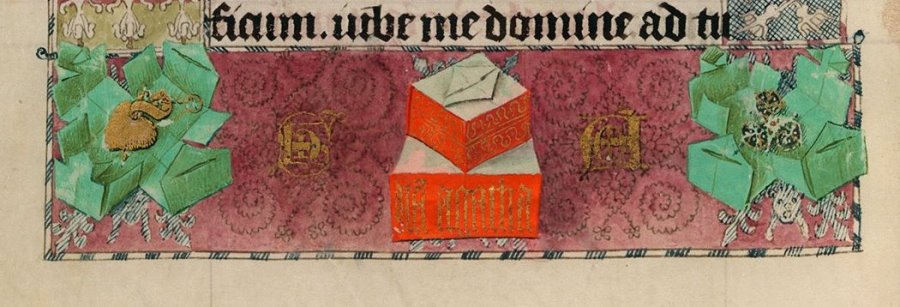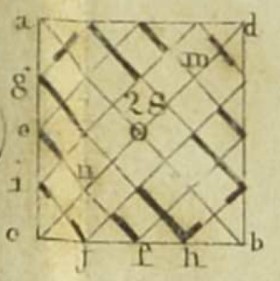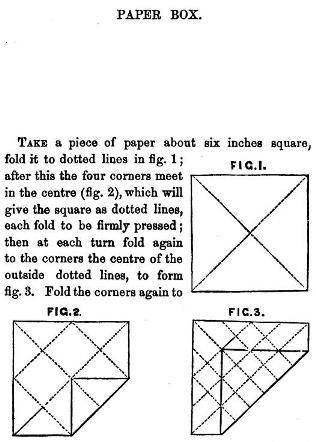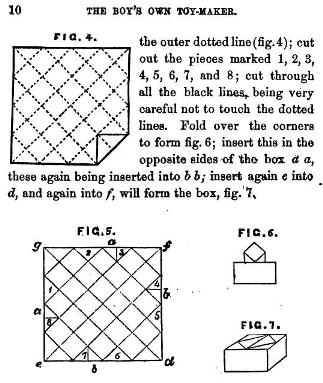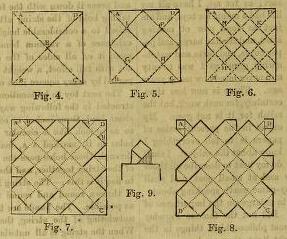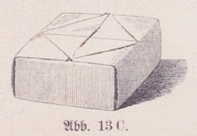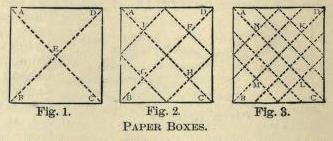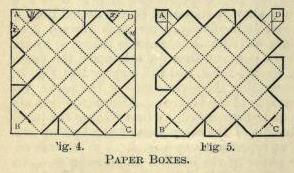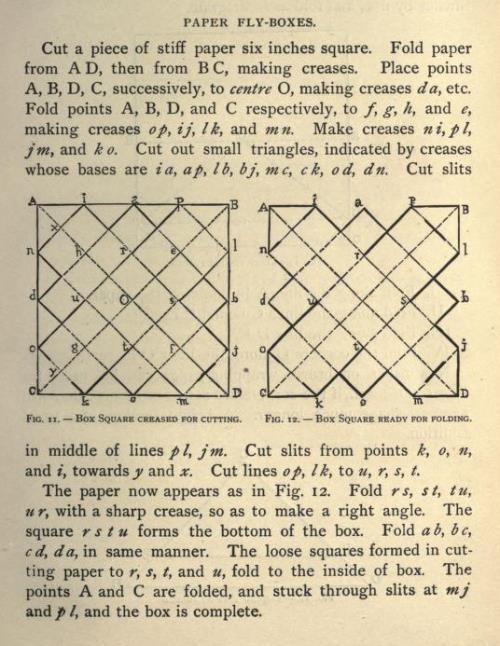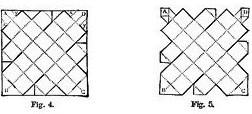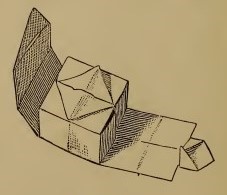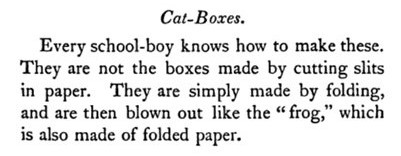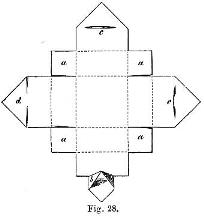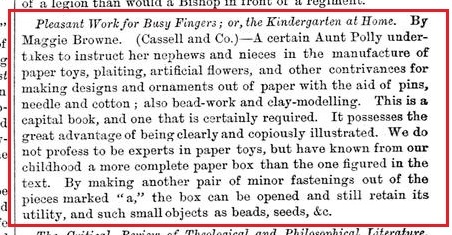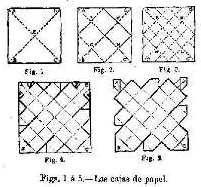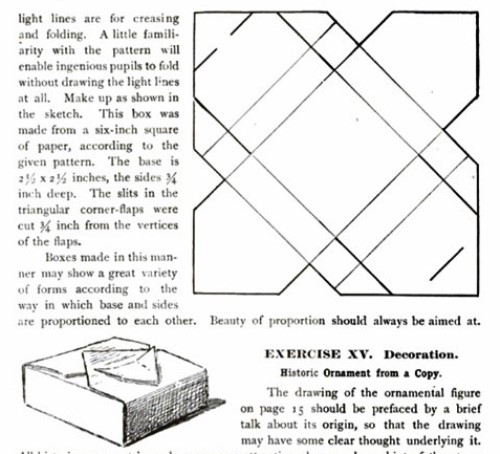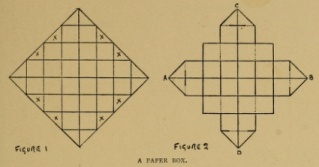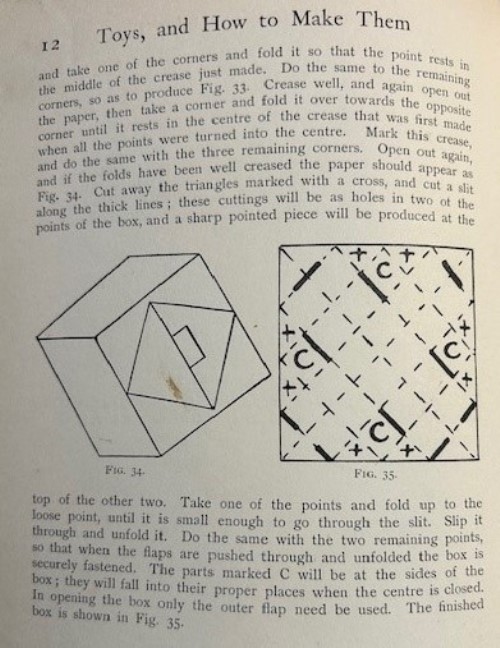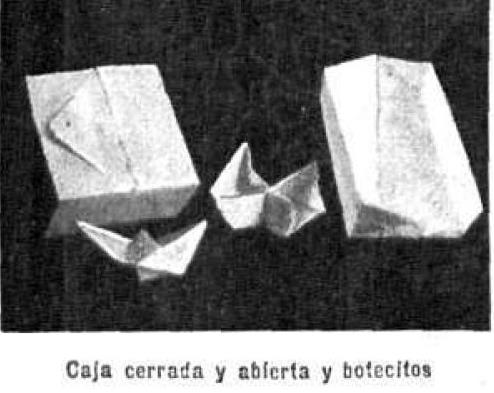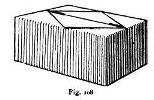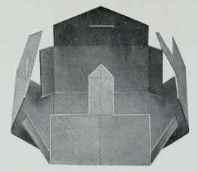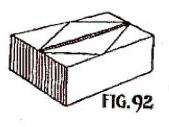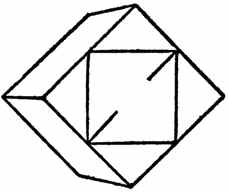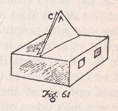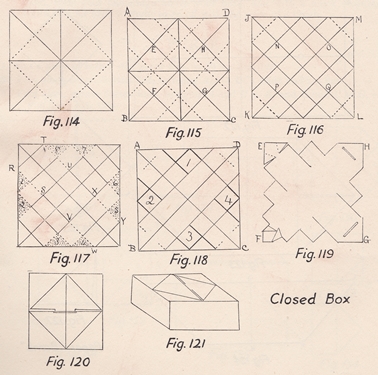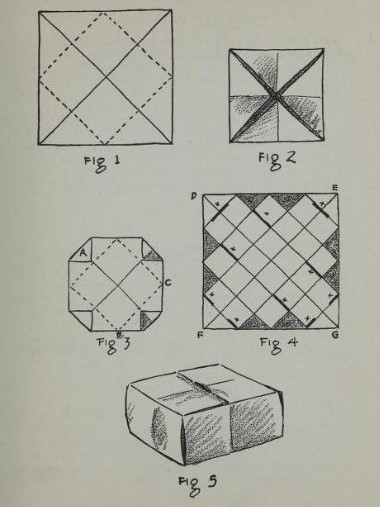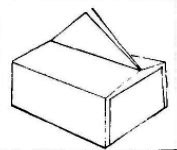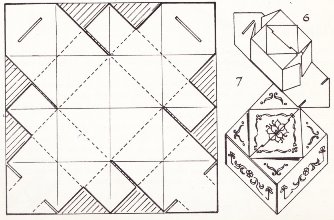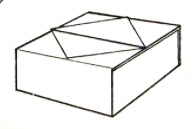| The Public Paperfolding History Project
Last updated 4/8/2025 x |
|||||||
| The Catherine of Cleves Box | |||||||
| This
page is being used to collect information about the
history of the paperfolding design I call the Catherine
of Cleves Box (see entry for c1440 below). Please contact
me if you know any of this information is incorrect or if
you have any other information that should be added.
Thank you. ********** Introduction As far as I know the appearance of this box in the Book of Hours of Catherine of Cleves was first drawn to the attention of the paperfolding world in a letter from Barbara Benson of Atlanta Georgia (aka Donna Serena de Riva) to David Lister, see here. ********** Chronology c1440 As far as I know this design first appears, as an incidental illustration at the foot of a page devoted to St Agatha, in the magnificent Flemish illustrated manuscript known as The Book of Hours of Catherine of Cleves which dates to around c1440. The box is folded from an irregular template and held together by tabs and pockets, and is completely unlike anything else that we know of from that date. The pictures below show the page as a whole and the detail of the box, pictured in both folded and unfolded form, from the bottom margin.
It is not clear whether the box pictured in the illustration would have been made from paper or parchment. Both materials would have been available at this date. I lean towards paper simply because the folding is so complex. Paper folds far more easily, and takes a crease far better, than parchment does. ********** 1840 Modern diagrams for this design first appear as 'Paper Box' in 'The School Boy's Holiday Companion' by T Kentish, which was published by Relfe and Fletcher in London in 1840
********** 1859 Diagrams also appear in 'The Boy's Own Toymaker' by Ebenezer Landells which was published in 1859 by Griffin and Farran in London and Shephard, Clark and Brown in Boston.
********** The design also appears: 1873 In 'The Popular Recreator', which was published by Cassell and Co in London in 1873.
********** 1876 In 'Des Kindes Erste Beschaftigungsbuch' by E Barth and W Niederley, which was first published in Bielefeld and Leipzig, and the foreword of which is dated October 1876.
********** 1880 In 'The Kindergarten Principle' by Mary J Lyschinska, which was published in London in 1880 by Wm Isbister Ltd.
********** As 'Les boites' in 'Un million de jeux et de plaisirs' by T de Moulidars, which was first published in 1880 and subsequently republished under the title 'Grande encyclopédie méthodique, universelle, illustrée, des jeux et des divertissements de l'esprit et du corps' in 1888. ********** 1881 In 'Cassell's Book of Indoor Amusements, Card Games and Fireside Fun', which was published by Cassell and Co in London in 1881.
********** 1883 In 'The American Girls's Home Book of Work and Play' by Helen Campbell, which was published by G P Putnam's Sons in 1883, where the diagrams are titled 'Paper Fly Boxes', although no further information about this description is given.
.********** 1884 In 'Jeux et Jouet du Jeune Age' by Gaston Tissandier, which was published by G Masson in Paris in 1884. In this version slits have been cut in the side of the box so that it can be used as a cage for insects.
********** 1887 As 'Paper Boxes' in 'The Home Book for Very Little People' by J H Vincent, which was published by Phillips and Hunt in New York in 1887.
********** As 'Paper Boxes' in 'How? Or Spare Hours Made Profitable for Boys and Girls' by Kennedy Holbrook, which was published by Worthington Co in New York in 1887.
********** 1889 In 'La Science Pratique' by Gaston Tissandier, which was published by G Masson in Paris in 1889.
********** 1890 There is reference to 'boxes made by cutting slits in paper' in 'Soap Bubbles and the Forces which Mould Them' by C V Boys was published by The Society for the Promotion of Christian Knowledge in London and by E and J B Young and Co in New York in 1890, which is probably a reference to the Catherine of Cleves Box design..
********** 1891 In 'Pleasant Work for Busy Fingers' by Maggie Browne, which was published by Cassell and Company in London in 1891. This book is an English version of 'Des Kindes Erste Beschaftigungsbuch' enhanced by the addition of a few extra designs.
Michel Grand has kindly sent me a review of this book which appeared in the Spectator of 2nd January 1892 and which appears to refer to an alternative version of this box which the writer remembers from their childhood. I do not, however, understand the nature of this alternative box.
********** The design also appears: 1893 As 'A box in the form of a square plinth' in 'Paper and Scissors in the Schoolroom' by Emily Weaver, which was published by Milton Bradley Company in Springfield, Massachusetts in 1893 contains
********** 1896 As 'Las Cajas' in 'Repertorio Completo de Todos los Juegos' by de Luis Marco y Eugenio de Ochoa y Ronna, which was published in Madrid by Bailly-Bailliere e hijos in 1896.
********** 1897 As 'Paper Box' in Teacher's Manual for the Prang Course in Drawing for Graded Schools, Books 1-6', by John S Clark, Mary Dana Hicks, Walter S Perry, which was published by the Prang Educational Company in Boston, New York and Chicago in 1897.
********** 1900 As ' Paper Boxes' in 'What Shall We Do Now?', by Edward Verral Lucas and Elizabeth Lucas, which was published in 1900.
********** 1904 As 'A Puzzle Paper Box' in 'The Book of Indoor Games' by J K Benson, which was published by C Arthur Pearson Limited in London in 1904.
********** 1904 As 'Quadrische gaschlossene schachtel' in 'Handbüchlein der Papierfaltekunst' (Handbook of Paperfolding Art) by J Sperl, which was first published by by H Hartleben's Verlag in Wien and Leipzig in 1904.
********** 1905 An illustration of the Catherine of Cleves Box appears in the Buenos Aires edition of the magazine 'Caras y Caretas', Issue 238, of 25th March 1905, where it is called the 'caja cerrada'.
********** 1910 As 'Geschlossenes Kästchen' (closed box) in Part 2 'Das Flechten' of 'Die Frobelschen Beschaftigungen' by Marie Muller-Wunderlich, which was published by Friedrich Brandstetter in Leipzig in 1910.
********** As 'Geschlossener Kasten' (Closed Box) in 'Allerlei Papierarbeiten' by Hildergard Gierke and Alice Kuczynski, which was published by Drud und Verlag B G Teubner in Leipzig and Berlin in 1910.
********** As 'A Paper Box' in 'Handicraft in the School', which was issued in four volumes by Gresham Publishing in London in 1910.
********** 1911 In 'Häusliche Kleinkunst und Bastelarbeit in Wort und Bild' by Hermann Pfeiffer, which was published by Verlag von Hermann Zieger in Leipzig in 1911.
********** 1913 As 'Prisma de broches' in 'Trabajo Manual' by C Champy Alvear, which was published by Cabaut y Cia in Buenos Aires in 1913.
*** This work also shows how the design can be varied to produce a cube-shaped box.
********** 1914 In an article in the issue of 'Los Muchachos', a Spanish children's magazine, for 25th July 1914.
********** 1920 In 'Paper Magic' by Will Blyth, which was first published by C Arthur Pearson in London in 1920.
********** 1922 'Houdini's Paper Magic', which was published by E P Dutton and Company of New York in 1922.
********** 1928 'Fun with Paperfolding' by William D Murray and Francis J Rigney was published by the Fleming H Revell Company, New York in 1928, where is is called 'The House'.
********** 1931 The revised 3rd edition of 'Lustiges Papierfaltbüchlein' by Johanna Huber, which was published by Otto Maier in Ravensburg, Germany in 1931. Of this design the text says, roughly, 'Our grandparents made them, each one smaller than the other, until there was a complete box, in the smallest part of which a surprise was usually hidden.
********** 1933 'Diversions and Pastimes' by R M Abraham, which was first published by Constable and Constable in London in 1933.
********** 1937 As the 'Closed Box' in 'Paper Toy Making' by Margaret Campbell, which was first published by Sir Isaac Pitman and Sons Ltd in London, probably in 1937, although both the Foreword and Preface are dated 1936, which argues that the book was complete at that date.
********** 1939 As 'Caja' in 'Plegado' by Rufino Yapur, which was published by Editores Independencia in Buenos Aires in 1939.
********** As 'A Puzzle Box' in 'Fun with Paper' by Joseph Leeming, which was published by Spencer Press Inc in Chicago in 1939.
********** 1940 Like the earlier ediotions, the 5th edition of 'Lustiges Papierfaltbüchlein' by Johanna Huber, which was published by Otto Maier in Ravensburg, Germany in 1927, contains diagrams for constructing the Catherine of Cleves Box. However, in this edition, the second picture has been redrawn so that it is presented as an open-topped rather than a closed box. This is odd because if the box was folded up in the way shown, the internal tabs and pockets could not be linked.
********** 1952 As 'Caja Sorpresa' in 'Una Hoja de Papel' by Lorenzo Herrero, which was published by Miguel A Salvatella in Barcelona in 1952.
********** 1960 As 'The Puzzle Box' in 'Paper Folding Fun' by Robert Harbin, which was published by Oldbourne in London in 1960.
********** 1968 As 'Gift Box', in 'Your Book of Paperfolding' by Vanessa and Eric de Maré, which was published by Faber and Faber in London in 1968.
********** |
|||||||

